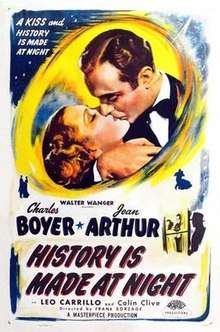History Is Made at Night (1937 film)
History Is Made at Night is a 1937 romantic drama with elements of comedy and spectacle, featuring Jean Arthur, Charles Boyer, and Colin Clive. It deals with a love triangle among a possessive shipping magnate, his beautiful wife, and a French headwaiter, with a spectacular ocean liner as a backdrop. The film was produced by Walter Wanger and directed by Frank Borzage.
| History is Made at Night | |
|---|---|
 Film poster | |
| Directed by | Frank Borzage |
| Produced by | Walter Wanger |
| Written by | C. Graham Baker |
| Screenplay by | Gene Towne Vincent Lawrence David Hertz |
| Starring | Charles Boyer Jean Arthur Leo Carrillo Colin Clive |
| Music by | Alfred Newman |
| Cinematography | David Abel Gregg Toland |
| Edited by | Margaret Clancey |
| Distributed by | United Artists |
Release date |
|
Running time | 95 min |
| Country | United States |
| Language | English |
| Budget | $821,791[1] |
| Box office | $948,500[1] |
Plot
Irene Vail decides to divorce her husband, the rich ship owner Bruce Vail, after he falsely accuses her of having an affair. Bitterly jealous and possessive of Irene, Vail learns that he can prevent the divorce from being finalized if he can provide evidence that she has been involved with another man within six months of filing for divorce. Vail pays his driver, Michael, to go to Irene's hotel room in Paris and pretend to be her lover, with the intention of having a private detective catch them in a compromising position. However, an unknown man overhears Irene's startled cry upon finding Michael in her room. A struggle ensues when the man defends Irene against Michael's unwanted advances, and ends with Michael on the floor, unconscious. When Vail and the detective burst into the room, the man threatens them with a gun, demands Irene's jewelry, and takes Irene hostage.
Once they are away, the intruder, Paul Dumond, returns Irene's jewelry and invites her to dine with him at the Château Bleu restaurant, where he works as a waiter. They literally dance the night away and Irene falls madly in love with him. In the morning, Irene returns to find Vail and the police in her room, for Michael is dead. Vail leads her to believe that Paul is responsible for his death, and blackmails her into coming back to America with him in exchange for Paul's freedom. Distraught that he is unable to find Irene, Paul reads in the newspaper that Irene has reunited with her husband and left for America. Sensing something is wrong, he embarks for the United States to find her, accompanied by Cesare, his good friend and head chef of Château Bleu.
In Manhattan, Paul and Cesare rehabilitate a restaurant, with the hope that its reputation will cause Irene to come to dine. The reunion takes place at last, but the happiness is short-lived when Paul learns that Michael is dead and a man has been arrested in Paris for the murder. Unwilling to let an innocent man pay for what he thinks is his crime, Paul embarks for Paris, and Irene joins him. They travel on the liner Princess Irene, which is owned by Vail and named after her.
Vail learns they are on the ship. In a rage, he radios orders to the captain to run at full speed, despite the danger of collision with an iceberg in the poor weather conditions, supposedly to break the record for fastest crossing. He actually hopes the ship will be sunk, killing Paul and Irene. The ship does strike an iceberg, and premature news reports state that the ship has sunk with horrendous loss of life, with the death toll possibly higher than the Titanic disaster. Consumed by guilt, Vail commits suicide and confesses to killing Michael in a suicide note. Fortunately, the Princess Irene's bulkhead doors manage to contain the water and prevent the ship from sinking. Paul and Irene and the other passengers rejoice when they hear they are to be rescued.
Cast
- Charles Boyer as Paul Dumond
- Jean Arthur as Irene Vail
- Leo Carrillo as Cesare
- Colin Clive as Bruce Vail
- June Preston as Daughter
- Ivan Lebedeff as Vail's Chauffeur
- George Meeker as Mr. Norton
- Lucien Prival as Private Detective
- George Davis as Maestro
- Byron Foulger as Vail Employee Reading from Newspaper
- Tom Ricketts as Old Man Getting in Lifeboat
- Señor Wences as 'Coco' Hand Trick Performer
Reception
The film made a profit of $17,450.[1]
The film was nominated for the American Film Institute's 2002 list AFI's 100 Years...100 Passions.[2]
References
- Bernstein, Matthew (1994). Walter Wanger, Hollywood Independent. Minneapolis: University of Minnesota Press. p. 437. ISBN 978-0-8166-9142-5. OCLC 476096270.
- "AFI's 100 Years...100 Passions Nominees" (PDF). Retrieved 2016-08-19.